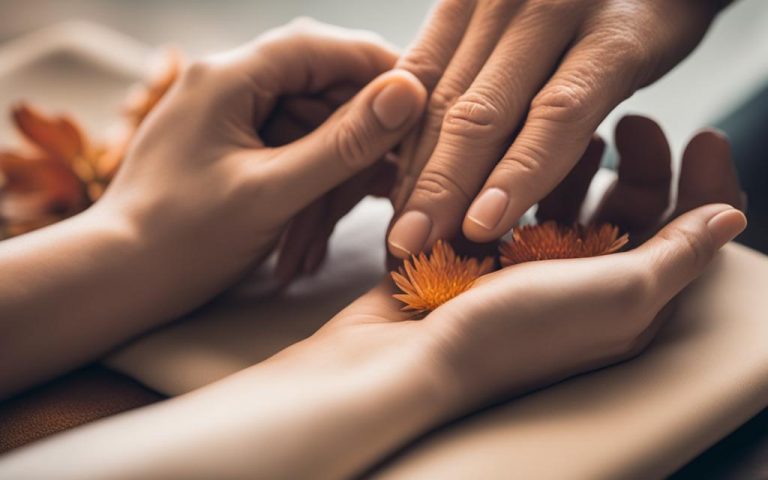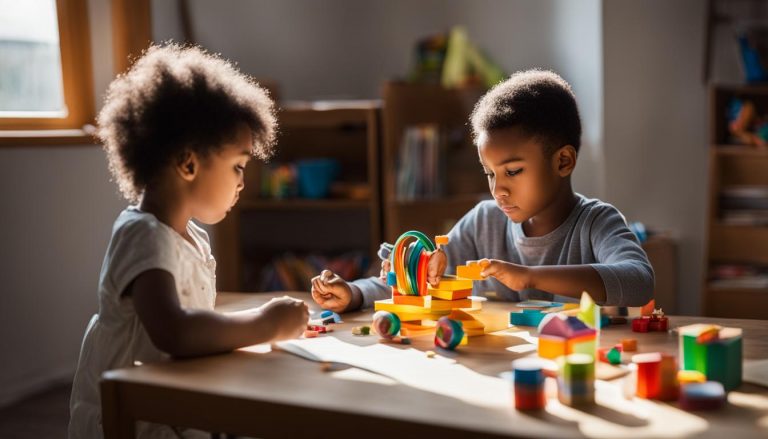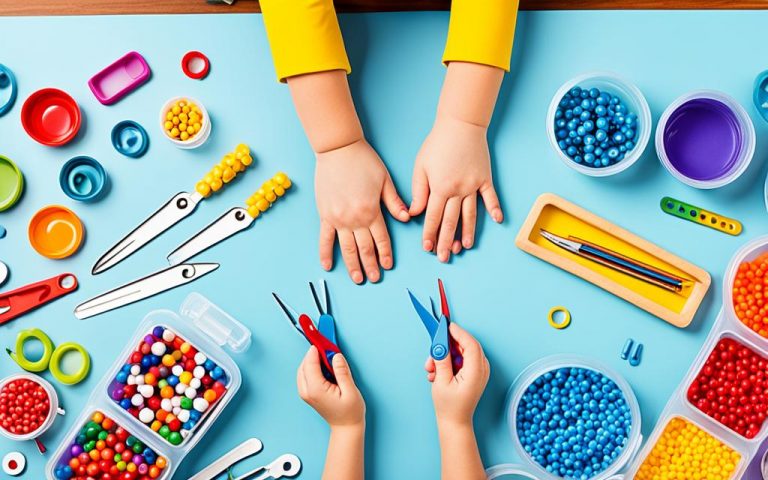Activation of Elderly People – Empowerment Guide
Welcome to our empowerment guide, where we explore the activation of elderly people and its importance in promoting their wellbeing and zes for life. In this guide, we will share strategies, tips, and insights to help empower older individuals to live vibrant and fulfilling lives.
As we age, it becomes essential to maintain an active and engaged lifestyle. Activation of elderly people is the key to unlocking a vibrant life. By embracing social connections, promoting mental and physical health, and addressing barriers to participation, we can empower older individuals to thrive.
Key Takeaways:
- Activation of elderly people is crucial for promoting their wellbeing and zest for life.
- Social connections play a significant role in the overall health and happiness of older individuals.
- Strategies such as cognitive-behavioral techniques and creating a “Connections Plan” can help promote social connectedness.
- Social isolation and loneliness have adverse effects on mental and physical health in elderly people.
- Social distancing during the COVID-19 pandemic presents challenges for maintaining social connections in older adults.
Understanding the Importance of Activation for Elderly People
As our loved ones age, it becomes crucial to understand the importance of activation for their overall wellbeing. Elderly people, just like anyone else, thrive when they are socially connected and engaged in activities that bring them joy. However, social connections, or the lack thereof, can significantly impact their mental and physical health.
Loneliness and social isolation have been identified as major risk factors for elderly individuals, and the COVID-19 pandemic has only exacerbated these challenges. The restrictions imposed to prevent the spread of the virus have led to increased feelings of loneliness and isolation among older adults, making it essential to find effective ways to promote social connectedness.
Research has shown that maintaining social connections can have a positive impact on the overall wellbeing of elderly individuals. Social interactions can help reduce the risk of developing mental health conditions such as depression and anxiety, improve cognitive function, and even enhance physical health outcomes. By fostering social connections, we can help our aging loved ones lead vibrant and fulfilling lives.
“Loneliness and the feeling of being unwanted is the most terrible poverty.” – Mother Teresa
The Impact of Social Connections on Elderly Wellbeing
A study conducted by Smith et al. (2020) found that elderly individuals who reported having strong social connections experienced higher levels of life satisfaction and subjective wellbeing. They were more likely to engage in healthy behaviors, such as regular exercise and nutritious eating, leading to improved physical health outcomes. Socially connected older adults also demonstrated better cognitive function and a reduced risk of cognitive decline.
| Benefit of Social Connections | Impact on Elderly Wellbeing |
|---|---|
| Mental Health | Reduced risk of depression and anxiety |
| Physical Health | Improved overall health outcomes |
| Cognitive Function | Enhanced cognitive abilities and reduced risk of decline |
| Quality of Life | Increased life satisfaction and subjective wellbeing |
It is crucial to recognize the significant role that social connections play in the wellbeing of elderly individuals. By understanding their importance and implementing strategies to foster social connectedness, we can empower our aging loved ones to live vibrant and fulfilling lives.
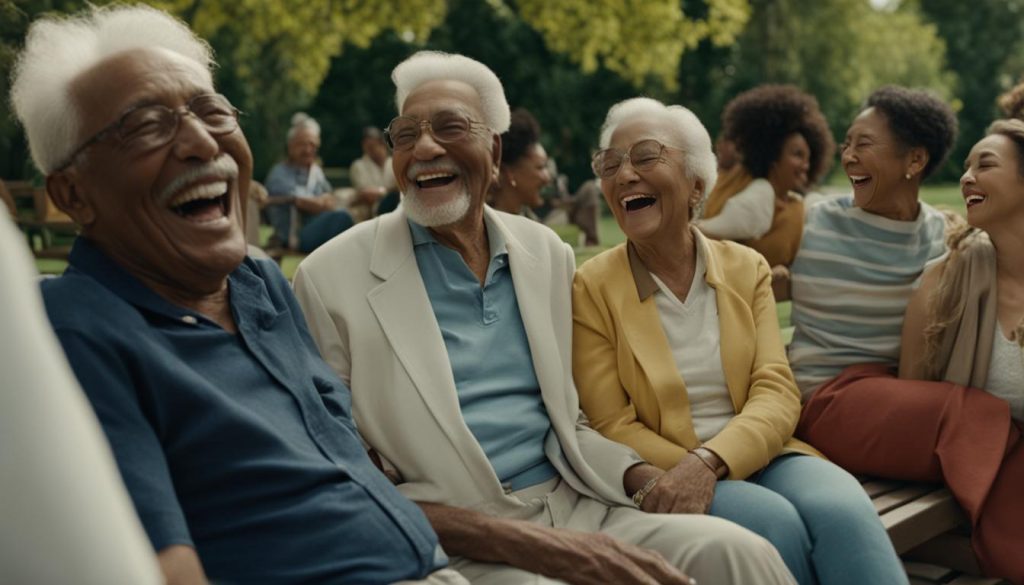
Strategies for Promoting Social Connectedness
When it comes to promoting social connectedness in elderly people, cognitive-behavioral strategies have shown great promise. These techniques can help combat feelings of isolation and loneliness, especially during challenging times such as the COVID-19 pandemic. By implementing these strategies, you can help enhance the overall well-being and quality of life for elderly individuals.
Social Perspectives and Mindset
Changing perspectives and mindset can have a profound impact on social connectedness. Encourage elderly individuals to shift their focus from what they cannot do to what they can do. This can open up new possibilities and interests, leading to increased social interactions. Remind them that it is never too late to learn or try something new, and encourage participation in activities that foster connection and engagement with others.
Coping with Anxiety
Many elderly individuals may experience anxiety when it comes to socializing, particularly if they have spent a significant amount of time in isolation. By practicing relaxation techniques such as deep breathing and mindfulness meditation, individuals can learn to manage their anxiety and feel more confident in social settings. Providing a supportive and understanding environment can also alleviate anxiety, creating a safe space for them to express themselves.
Creative Problem-Solving
During times of social distancing, it is crucial to think outside the box and find creative ways to connect. Encourage elderly individuals to explore new technologies and online platforms that can help them stay connected with friends, family, and communities. Virtual gatherings, online classes, and social media platforms can provide opportunities for interaction and combat social isolation. Additionally, problem-solving together with elderly individuals can help identify personalized solutions to overcome any barriers they may face in maintaining social connections.
By implementing these cognitive-behavioral strategies, you can help promote social connectedness and support the well-being of elderly individuals. Remember, fostering social connections is essential for their mental and physical health, particularly during times of social distancing. By encouraging a positive mindset, addressing anxiety, and finding creative solutions, you can make a significant difference in their lives.
| Benefits of Cognitive-Behavioral Strategies for Promoting Social Connectedness |
|---|
| Improved mental health and well-being |
| Enhanced social interactions and relationships |
| Reduced feelings of isolation and loneliness |
| Increase in overall life satisfaction |
Implementing these strategies can contribute to a vibrant and fulfilling life for elderly individuals. By fostering social connectedness, you can empower them to enjoy meaningful interactions, maintain a sense of purpose, and thrive in their later years.
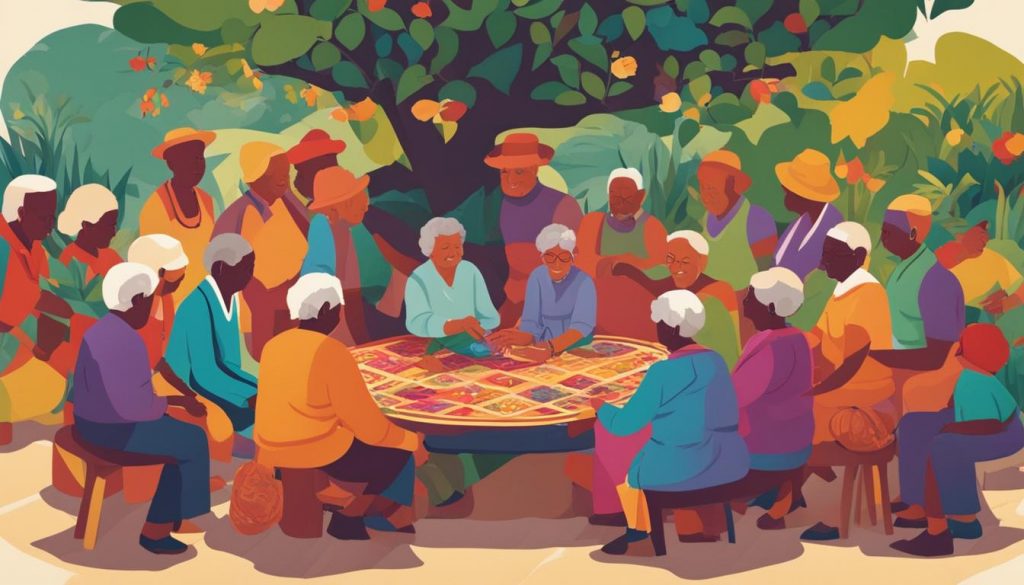
The Role of Social Connections in Mental and Physical Health
Social connections play a crucial role in promoting the mental and physical health of elderly individuals. Studies have consistently shown that strong social networks have a positive impact on overall wellbeing and can contribute to a vibrant and fulfilling life. Maintaining social connections is particularly important for older adults, as it helps combat feelings of loneliness and social isolation, which can have detrimental effects on their health.
According to research, individuals who have robust social connections are more likely to experience improved mental health outcomes. Regular social interactions provide opportunities for emotional support, companionship, and a sense of belonging, which can help alleviate symptoms of depression and anxiety. Having a strong social network also acts as a protective factor against cognitive decline and dementia, as it stimulates cognitive functioning and promotes brain health.
“Social connections are not only vital for happiness and quality of life but also have a significant impact on physical health outcomes.”
The benefits of social connections extend beyond mental health. They also have a profound influence on an individual’s physical well-being. Engaging in social activities and maintaining meaningful relationships can lead to increased physical activity, improved self-care behaviors, and a reduced risk of chronic diseases such as cardiovascular conditions and obesity. Furthermore, social connections provide a support system that can encourage healthy lifestyle choices, such as maintaining a balanced diet and adhering to medical treatments.
It is essential to recognize the critical role that social connections play in the overall health of elderly individuals. Healthcare professionals, caregivers, and society as a whole should prioritize efforts to promote social interactions, combat social isolation, and create supportive environments for older adults. By fostering strong social connections, we can enhance the mental and physical well-being of our elderly population and enable them to lead vibrant lives.
| Benefits of Social Connections | Mental Health | Physical Health |
|---|---|---|
| Reduces feelings of loneliness and social isolation | Alleviates symptoms of depression and anxiety | Increases physical activity |
| Provides emotional support and companionship | Acts as a protective factor against cognitive decline | Improves self-care behaviors |
| Enhances sense of belonging and social integration | Promotes brain health and cognitive functioning | Reduces the risk of chronic diseases |
The Effects of Social Distancing on Social Connections
In these challenging times of social distancing, older adults face significant challenges in maintaining social connections. The restrictions imposed to protect their health can inadvertently lead to social isolation and loneliness, which can have detrimental effects on their mental and physical well-being.
Social connections play a crucial role in the lives of older adults, providing them with a sense of belonging, support, and purpose. However, the COVID-19 pandemic has disrupted these connections, making it more difficult for older adults to engage in social activities, visit family and friends, and participate in community events. As a result, they may experience increased feelings of loneliness and isolation, which can negatively impact their overall health.
Despite these challenges, innovative solutions are emerging to support social connections among older adults during social distancing measures. Virtual platforms and technology have become crucial tools for maintaining social interactions, enabling older adults to connect with loved ones, participate in online communities, and engage in virtual activities. Community organizations and local initiatives are also adapting to the current situation, offering support services such as grocery delivery, phone companionship, and online social events.
It is important for caregivers, family members, and friends to be proactive in helping older adults maintain their social connections. Regular communication through phone calls, video chats, or letters can make a significant difference in alleviating loneliness and providing emotional support. Encouraging older adults to explore new hobbies, learn new skills, or engage in online classes can also help them stay connected and actively participate in meaningful activities.
| Effects of Social Distancing on Older Adults: | Ways to Mitigate Impact: |
|---|---|
| Increased feelings of loneliness and isolation | Regular communication through phone calls, video chats, or letters |
| Reduced opportunities for social interactions and engagement | Encouraging participation in virtual activities and online communities |
| Impact on mental and physical well-being | Promoting regular exercise, mindfulness practices, and self-care |
| Limited access to support services and resources | Connecting with local community organizations offering assistance |
By actively supporting older adults in maintaining their social connections during social distancing measures, we can minimize the negative impact of isolation and loneliness. Together, we can ensure that older adults continue to lead vibrant and fulfilling lives, even in these challenging times.
Practical Tips for Carers and Caregivers
As a carer or caregiver for elderly individuals, your role is crucial in supporting their overall wellbeing and activation. By creating a supportive and engaging environment, promoting social interactions and activities, and addressing any barriers to participation, you can make a significant difference in their lives. Here are some practical tips to help you in your caregiving journey:
1. Create a supportive and engaging environment:
- Arrange the living space to be safe, comfortable, and accessible. Remove any hazards or obstacles that may pose a risk to the elderly person’s safety.
- Encourage personalization of the living space with familiar and meaningful objects to create a sense of belonging and comfort.
- Establish a daily routine that includes a variety of activities, such as physical exercise, cognitive stimulation, hobbies, and social interactions.
2. Promote social interactions and activities:
- Encourage the elderly person to maintain relationships with family, friends, and community members through phone calls, video chats, or in-person visits when possible.
- Organize social activities, such as group outings, game nights, or community events, that allow for socialization and connection with others.
- Support participation in local clubs, organizations, or volunteer opportunities that align with the interests and abilities of the elderly person.
3. Address barriers to participation:
- Identify and address any physical or cognitive challenges that may hinder the elderly person’s ability to engage in activities. Adapt activities and provide necessary support or assistive devices.
- Consider transportation options or assistance to help the person participate in social events or activities outside the home.
- Consult healthcare professionals, such as occupational therapists or geriatric specialists, for guidance on managing specific challenges and maximizing the elderly person’s participation.
Remember, every elderly individual is unique, and it’s important to tailor your approach to their specific needs and preferences. By implementing these practical tips, you can enhance their quality of life and contribute to their overall activation and wellbeing.
| Tip | Description |
|---|---|
| Create a supportive and engaging environment | Arrange the living space to be safe and comfortable, encourage personalization, and establish a daily routine. |
| Promote social interactions and activities | Encourage maintaining relationships, organize social activities, and support participation in clubs or organizations. |
| Address barriers to participation | Identify and address challenges, consider transportation options, and consult healthcare professionals for guidance. |
Remember, as a carer or caregiver, your role is invaluable in providing the necessary support and care for elderly individuals. By implementing these practical tips and adapting them to the specific needs of the person you care for, you can contribute to their activation and overall wellbeing.
Conclusion
In conclusion, the activation of elderly people is crucial for promoting their overall wellbeing and ensuring a vibrant life. As discussed in this article, social connectedness plays a vital role in the mental and physical health of older adults. The COVID-19 pandemic has further highlighted the challenges faced by elderly individuals in maintaining social connections, making it more important than ever to find effective strategies.
By implementing evidence-informed cognitive-behavioral strategies and creating a “Connections Plan,” caregivers and carers can help support the activation of elderly people and maintain their social connections, even during social distancing restrictions. It is essential to prioritize the management of loneliness and social isolation as preventive interventions, as these factors can have significant negative impacts on quality of life and health outcomes.
As a caregiver or carer, you have the power to make a positive impact on the lives of elderly individuals. By creating a supportive and engaging environment, promoting social interactions and activities, and addressing barriers to participation, you can contribute to their overall wellbeing. Remember, small changes can make a big difference in the activation of elderly people, enhancing their zest for life and promoting a vibrant future.
FAQ
What is activation of elderly people?
Activation of elderly people refers to promoting their physical, mental, and social engagement to enhance their overall wellbeing and zest for life.
Why is activation important for elderly people?
Activation helps to combat social isolation and loneliness, which can have negative effects on their health and wellbeing. It promotes social connections, mental stimulation, and physical activity.
How does social isolation impact elderly people?
Social isolation can lead to increased rates of depression, anxiety, cognitive decline, and physical health issues. It is important to find effective ways to promote social connectedness.
What strategies can promote social connectedness in elderly people?
Strategies such as changing perspectives, coping with anxiety, practicing mindfulness meditation, and problem-solving creative ways to connect can help promote social connectedness in elderly people.
What is a “Connections Plan”?
A “Connections Plan” is a personalized plan that helps maintain social connections during times of social distancing by exploring alternative ways to connect and engage with others.
How do social connections impact mental and physical health in elderly people?
Social connections play a vital role in promoting mental and physical health in elderly people. They help reduce the risk of loneliness, improve emotional well-being, and can lead to healthier lifestyle choices.
What challenges do older adults face in maintaining social connections during the COVID-19 pandemic?
Older adults may face challenges such as limited access to technology, fear of infection, and reduced opportunities for in-person social interactions, which can have a negative impact on their mental and physical health.
What practical tips can carers and caregivers follow to support the activation of elderly people?
Carers and caregivers can create a supportive environment, promote social interactions and activities, and address any barriers to participation. They can also adapt care routines and activities to meet the individual needs and preferences of elderly individuals.
How can the strategies and tips provided in this article make a positive impact on the lives of elderly individuals?
By implementing the strategies and tips provided, carers, caregivers, and elderly individuals themselves can promote social connectedness, mental and physical health, and overall wellbeing, leading to a more vibrant and fulfilling life.


